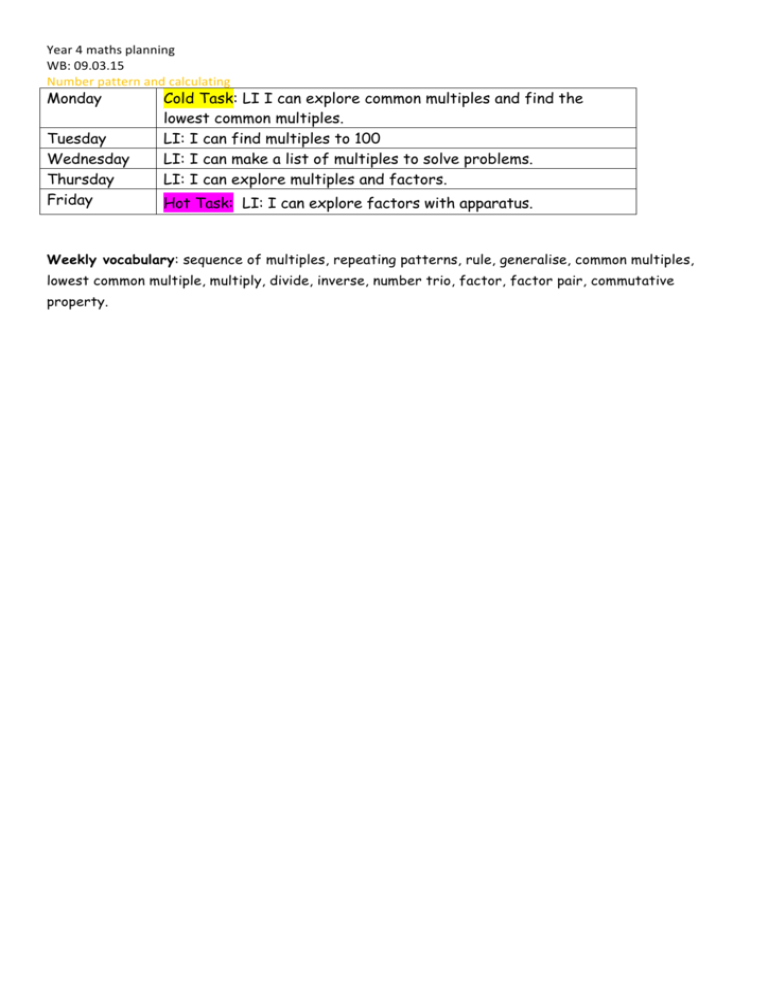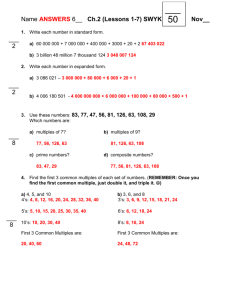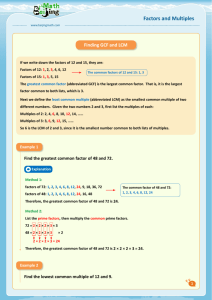Monday Cold Task: LI I can explore common multiples and find the
advertisement

Year 4 maths planning WB: 09.03.15 Number pattern and calculating Monday Tuesday Wednesday Thursday Friday Cold Task: LI I can explore common multiples and find the lowest common multiples. LI: I can find multiples to 100 LI: I can make a list of multiples to solve problems. LI: I can explore multiples and factors. Hot Task: LI: I can explore factors with apparatus. Weekly vocabulary: sequence of multiples, repeating patterns, rule, generalise, common multiples, lowest common multiple, multiply, divide, inverse, number trio, factor, factor pair, commutative property. Year 4 maths planning WB: 09.03.15 Number pattern and calculating Mental/Oral: Monday Can you count forward and back in multiples of 6, 7 & 9 from…….? Extend beyond 100. LI: I can explore common multiples and find the lowest common multiples. Cold Task two next door neighbours have milk delivered by the same delivery van. One neighbour has the milk delivered every 4 days and the other every 5 days. Can you help the van driver work out for the coming month which dates the neighbours need to have milk delivered and whether they will ever need the milk delivered on the same day. How will multiples and common multiples help you with this problem? Can you use the shapes, 10s number line or rods to work out the delivery dates? Plenary: Label: Can you think of any other real life situations where the maths we have been learning would help you? Maths booster group Year 4 maths planning WB: 09.03.15 Number pattern and calculating Mental/Oral: Tuesday In pairs can you find all the factors of………..? Lesson Objective: LI: I can find multiples to 100. Challenge: Can you find all the multiples of 3 & 5 to 100? Mrs Wilson thinks that there is a relationship between dividing. She thinks that 100 divided by the times table number will give you the number of multiples to 100. Prove her right or wrong. Let us try it together with multiples of 4. 100 divided by 4 = 25. So we should find 25 multiples of 4 up to 100. How can we do this systematically? How can we record our findings? Plenary: Can you find numbers that have only two factors? Question for labels: Can you write all the special words we use when we are talking about multiplying? Children in need of maths booster Year 4 maths planning WB: 09.03.15 Number pattern and calculating Mental/Oral: Wednesday Can you find the number less than 100 which has the most factors? Lesson Objective: LI: I can make a list of multiples to solve problems. Challenge: In my feely bag. I have some pegs. There are fewer than 15 pegs; they can be made into 3 patterns, with 1 peg left over. What could the smallest amount of pegs be? Can you find all the possibilities up to 15? The final clue is that the pegs can be rearranged into 5 patterns with no pegs left over. Plenary: I am thinking of a number that is a multiple of 5 and a multiple of 4 and is less than 30. Question for label: Can you write 4 multiples of 6? Children that need maths booster Year 4 maths planning WB: 09.03.15 Number pattern and calculating Mental/Oral: Thursday LI: I can explore multiples and factors. Challenge: I have a tower made of 6 interlocking cubes of the same colour. This represents a block of flats an architect wants to build, but the tower is too high. Can you explore other possible designs for the block of flats that use the same number of cubes? Work systematically. Discuss the designs in terms of bottom floor and height. Each block needs to have the same number of cubes or flats on each floor. How many designs are there in total? Plenary: Play a game where children do actions or call out words for a given multiple. Label question: What would happen with 14 towers? Can you predict without making the towers? Year 4 maths planning WB: 09.03.15 Number pattern and calculating Mental/Oral: Friday Rehearse all times table facts to 12 x 12. Hot Task LI: I can explore factors with apparatus. Challenge: 24 children have signed up for a games club and the teacher would like to organise these children into teams of equal size. Can you use shapes or rods to illustrate this? Can I have a remainder? Plenary: List some numbers and talk with children about which numbers have these factors. Label: Can you highlight off any more of your key vocabulary for this week? Children for maths booster group






